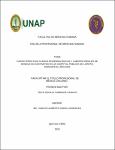| dc.contributor.advisor | Coral Gonzáles, Carlos Alberto | |
| dc.contributor.author | Taminche Canayo, Ruth Cecilia | |
| dc.date.accessioned | 2023-08-23T13:39:23Z | |
| dc.date.available | 2023-08-23T13:39:23Z | |
| dc.date.issued | 2023 | |
| dc.identifier.other | 616.91852 T18 2023 | |
| dc.identifier.uri | https://hdl.handle.net/20.500.12737/9298 | |
| dc.description.abstract | Objectives: The general objective was to determine the clinical-epidemiological and laboratory characteristics of dengue in pregnant women in a public hospital in Loreto, during the year 2022. Materials and methods: A descriptive, cross-sectional, observational study included 108 pregnant women with a presumptive diagnosis of dengue from the Gynecology and Obstetrics area of the Hospital Iquitos César Garayar García from January to December 2022. A collection instrument validated by experts was used, obtaining the information from medical records. An observational, descriptive, cross-sectional analysis was carried out to determine the clinical-epidemiological and laboratory characteristics of dengue in pregnant women. Results: The prevailing age ranged from 20-34 years, most of them finished high school, are cohabiting and independent (housewives). The largest number of pregnant women come from urban areas, from the district of Belén, and the majority of their nutritional status is overweight. They had no history of dengue (98.1%). In the gynecologic and obstetric history, the majority were affected in the third trimester, but there was a greater number of admissions in preterm pregnant women, the pregnant women were more primiparous, the majority did not have abortions, and more than half were adequately controlled. The largest number of concomitant diseases in pregnant women were different from diabetes and hypertension. More pregnant women were hospitalized from 1 to 5 days, more than half had a cesarean section. There were 12 positive patients for NS1, but 72 for clinical, 46 for laboratory and 31 for both. Both hemoglobin and hematocrit were related in all pregnant women, without having high amounts, platelets, in most patients, had a normal value, leukocytes, in half, maintained a low value. Conclusions: There was a relationship between the clinical and epidemiological characteristics and the laboratory findings. Likewise, the most frequent warning signs were abdominal pain, vomiting and nausea. The most frequent maternal complications were anemia and hemorrhage. | en_US |
| dc.description.abstract | Objetivos: El objetivo general fue determinar las características clínico-epidemiológicas y laboratoriales de dengue en gestantes en un hospital público de Loreto, durante el año 2022. Materiales y métodos: Estudio descriptivo de corte transversal, observacional, incluyó 108 gestantes con diagnóstico presuntivo de dengue del área de Ginecoobstetricia del Hospital Iquitos César Garayar García de enero a diciembre del 2022. Se utilizó un instrumento de recolección validado por expertos, se obtuvo la información de las historias clínicas. Se realizó un análisis observacional, descriptivo, transversal para determinar las características clínico-epidemiológicas y laboratoriales de dengue en gestantes. Resultados: La edad prevalente estuvo comprendida entre 20-34 años, la mayoría de ellas culminaron la secundaria, son convivientes e independientes (amas de casa). La mayor cantidad de gestantes provienen de zonas urbanas, del distrito de Belén, y su estado nutricional de la mayoría es el sobrepeso. No tuvieron antecedente de dengue (98.1%). En los antecedentes ginecoobstétricos, la mayoría fue afectada en el tercer trimestre, pero hubo mayor cantidad de ingresos en gestantes pretérminos, las gestantes fueron en mayor cantidad primigestas, la mayoría no tuvo abortos, y más de la mitad se controlaron adecuadamente. La mayor cantidad de enfermedades concomitantes en las gestantes fueron diferentes a diabetes e hipertensión. Más gestantes se quedaron hospitalizadas de 1 a 5 días, más de la mitad tuvieron parto por cesárea. Hubo 12 pacientes positivas por NS1, pero 72 por clínica, 46, por laboratorio y 31 por ambos. Tanto la hemoglobina como el hematocrito tuvieron relación en todas las gestantes, sin tener cantidades elevadas, las plaquetas, en la mayoría de las pacientes, tuvieron un valor normal, los leucocitos, en la mitad mantuvieron un valor bajo. Conclusiones: Hubo relación entre las características clínico-epidemiológicas y los hallazgos laboratoriales. Así mismo, los signos de alarma más frecuentes fueron el dolor abdominal, vómitos y náuseas. Las complicaciones maternas más frecuentes fueron anemia y hemorragia. | es_PE |
| dc.format | application/pdf | es_PE |
| dc.language.iso | spa | es_PE |
| dc.publisher | Universidad Nacional de la Amazonía Peruana | es_PE |
| dc.rights | info:eu-repo/semantics/openAccess | * |
| dc.rights.uri | https://creativecommons.org/licenses/by/4.0/ | * |
| dc.subject | Dengue | es_PE |
| dc.subject | Mujeres embarazadas | es_PE |
| dc.subject | Diagnóstico clínico | es_PE |
| dc.subject | Aedes | es_PE |
| dc.subject | Epidemiología | es_PE |
| dc.title | Características clínico-epidemiológicas y laboratoriales de dengue en gestantes en un hospital público de Loreto, durante el año 2022 | es_PE |
| dc.type | info:eu-repo/semantics/bachelorThesis | es_PE |
| thesis.degree.discipline | Medicina Humana | es_PE |
| thesis.degree.grantor | Universidad Nacional de la Amazonía Peruana. Facultad de Medicina Humana | es_PE |
| thesis.degree.name | Médico Cirujano | es_PE |
| dc.subject.ocde | https://purl.org/pe-repo/ocde/ford#3.03.09 | es_PE |
| renati.author.dni | 71272214 | |
| renati.advisor.orcid | https://orcid.org/0000-0003-1671-5636 | |
| renati.advisor.dni | 05239595 | |
| renati.type | https://purl.org/pe-repo/renati/type#tesis | es_PE |
| renati.discipline | 912016 | es_PE |
| renati.level | https://purl.org/pe-repo/renati/level#tituloProfesional | es_PE |
| renati.juror | Vásquez Vásquez, Javier | |
| renati.juror | Casapia Morales, Wilfredo Martín | |
| renati.juror | Baldeón Ríos, Jorge Luis | |
| dc.publisher.country | PE | es_PE |





